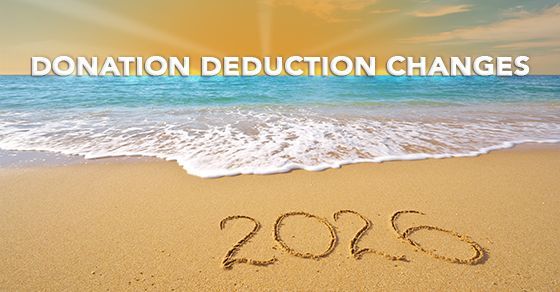December 16, 2025
Beginning in 2026, individuals who itemize deductions and donate to charity will face a new limit on their charitable deductions. And in some cases, they’ll face two new limits. But there’s some good news for nonitemizing individuals who make charitable donations. New charitable deduction floor Under the One Big Beautiful Bill Act (OBBBA), starting in 2026, if you itemize deductions, your otherwise allowable charitable deduction will be reduced by 0.5% of your adjusted gross income (AGI). Put another way, your 2026 charitable deduction will be limited to the amount that exceeds 0.5% of your 2026 AGI. AGI includes all taxable income items and is reduced by above-the-line deductions like the write-offs for traditional IRA contributions, self-employed retirement plan contributions, self-employed health insurance premiums, 50% of self-employment tax, qualified education loan interest expense and Health Savings Account contributions. Let’s look at an example: You and your spouse file jointly in 2026. Your AGI is $400,000 and you make charitable donations of $10,000. Your allowable itemized charitable deduction for 2026 is limited to $8,000 [$10,000 − (0.5% × $400,000)]. New itemized deduction limitation Also under the OBBBA, beginning in 2026, itemized deductions — including charitable deductions — for individuals in the top federal income tax bracket of 37% will be reduced by the lesser of: 1) 2/37 times the amount of otherwise allowable itemized deductions, or 2) 2/37 times the amount of taxable income (before considering those deductions) in excess of the applicable threshold for the 37% tax bracket. That sounds complicated, but generally the limitation will mean that the tax benefit of itemized deductions for taxpayers in the 37% bracket will be as if they were in the 35% bracket. When a taxpayer has charitable deductions, the charitable deduction floor rule will be applied before the itemized deduction limitation. However, only high-income individuals will be affected by the itemized deduction limitation. Planning tips for 2025 and beyond If you’ll itemize this year and next, consider advancing some charitable donations that you normally would make in 2026 into this year to avoid the impact of the new 0.5%-of-AGI charitable deduction floor that will take effect next year. In future years, consider taking steps to reduce your AGI to minimize the impact of the charitable deduction floor. For instance, you can recognize capital losses from securities held in taxable brokerage accounts and make bigger deductible or pretax retirement plan contributions. Another option is to bunch your charitable giving into alternating years. For example, instead of donating $10,000 to charity every year, donate $20,000 every other year. Because the charitable deduction reduction is based on AGI, not the amount of the deduction, you can increase your tax benefit with this strategy (assuming your AGI is steady from year to year). In the previous example, if you make $10,000 in donations in 2026 and another $10,000 in 2027 and your AGI remains at $400,000 for both years, each year your deduction will be reduced by $2,000, for a total deduction over two years of $16,000. But if you bunch your donations into 2027, your 2027 $20,000 deduction will be reduced by that same $2,000. You won’t have an itemized charitable deduction for 2026, but your total deduction for the two-year period will be $18,000. It’s important to review your overall tax picture before implementing a bunching strategy. For example, if not being able to claim an itemized charitable deduction on your 2026 income tax return would push you into a higher income tax bracket, then bunching may not be beneficial. New charitable deduction for nonitemizers If you don’t have enough total itemized deductions — including charitable donations — to exceed your standard deduction, you’ll save more tax by claiming the standard deduction. In recent years, including 2025, nonitemizers haven’t been allowed to deduct any charitable contributions. But starting in 2026, the OBBBA reinstates the COVID-era deduction for cash donations by nonitemizers, subject to an increased annual limit of $1,000, or $2,000 for joint filers. (The limits were $300 and $600, respectively, for 2021 when this nonitemizer deduction was last available.) The definition of “cash contribution” may be broader than you think. It includes gifts made by debit or credit card, check, ACH, online payment platform, and payroll deduction. But be aware that this deduction doesn’t reduce your AGI. This year and next Limits to charitable deductions are nothing new. Limits beyond the ones discussed here have long applied. For example, only donations to qualified charities are eligible, proper substantiation is required, and other AGI-based limits apply in certain situations. Contact us to discuss what you can deduct on your 2025 return, last-minute 2025 planning opportunities and your 2026 donation strategy. © 2025










